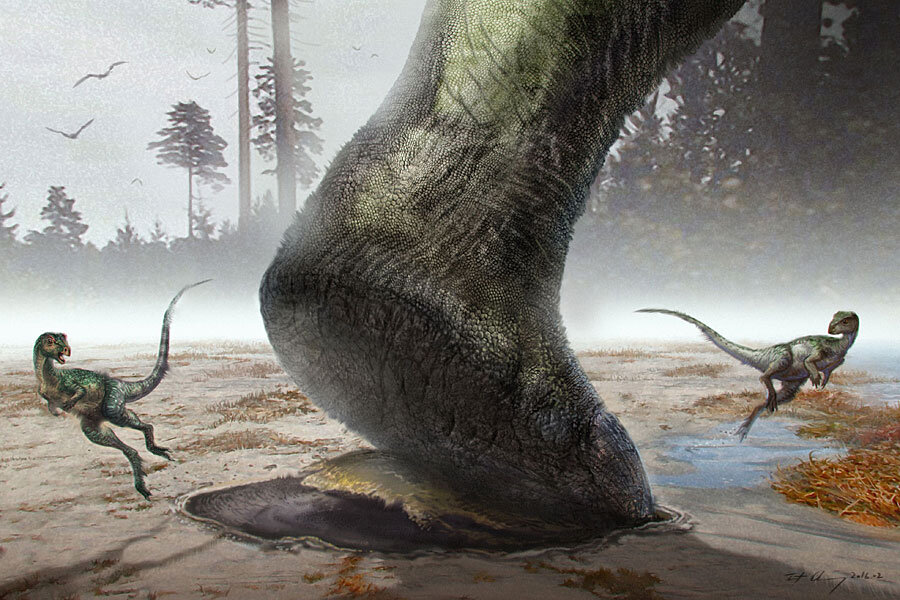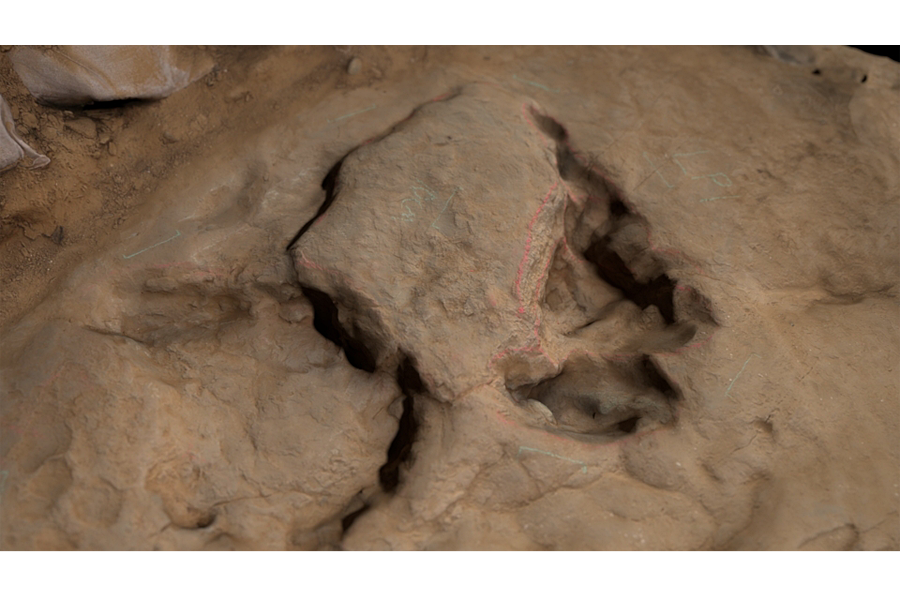Dinosaur tracks: Why would a four-footed dino leave two-footed prints?
Loading...
An enormous sauropod dinosaur ambled across present-day northern China some 125 to 140 million years ago. But as it moved, the four-legged dinosaur only left imprints from its hind feet.
Scientists initially thought the mysterious footprints might mean the dinosaur was actually swimming, pushing off against the bottom of a body of water with its back legs while the front legs paddled. But as exciting as a swimming dinosaur sounds, a team of researchers argue that these prints were not made by a humongous swimming dinosaur in a paper published Thursday in the journal Scientific Reports.
"In the grand scheme of things, it's probably not doing anything more spectacular than just walking along," study co-author Peter Falkingham tells The Christian Science Monitor in an interview. Dr. Falkingham has argued for years that strange hind- or fore-foot only tracks don't have to mean the animal was swimming.
But the tracks are still worth studying. "These footprints, they give us a better idea of what the foot is doing than we've had before," he says.
Sauropod footprints tend to be relatively flat, he explains. These dinosaurs – including brontosaurus brachiosaurus, diplodocus, and others – were famously humongous (the largest stretched over 100 feet long), so they would have been quite heavy. And the animals would have stepped somewhat vertically, like an elephant.
But these prints aren't just flat circles. "It's kind of pushed up and there's a big bulge in the middle," Falkingham says. "We think it's from the toes digging in and pushing the sediment back."
The dinosaur probably left these enigmatic footprints because "the sediment happens to be at the right consistency that the front feet aren't really making any footprints and the back feet are kicking in the sediment in this way," Falkingham says.
Although this dinosaur probably wasn't doing anything all that strange, the weird prints can still provide new insight into the extinct animal's life.
Sauropod dinosaurs walked on four legs, so if just their hind feet were making prints, that says something about the distribution of the animals' body mass, Falkingham says. So in life, the sauropods' center of gravity was probably closer to their hind legs.
"The results of this paper aren't too surprising," University of Edinburgh paleontologist and evolutionary biologist Steve Brusatte, who was not involved in the study, tells the Monitor in an email.
"But this study is a reminder of the wealth of dinosaur tracksites out there, and how by studying them in detail you can make inferences about how these amazing animals lived and behaved," Dr. Brusatte says.
Footprints are considered "trace fossils," clues left behind by an animal rather than parts of the animal itself. "An animal only has one skeleton, but it could conceivably leave millions of footprints over its life," Brusatte says. "And footprints record real events: animals moving around, interacting with each other, interacting with their environments. They are records of behavior."
"That is really critical if we want to study animals like sauropods: long-extinct creatures that are so different than anything alive today, and which push the boundaries of what evolution can achieve," he says.
"These animals were very, very large," Falkingham says. "They were an order of magnitude larger than anything alive today." Blue whales come the closest in size to a massive sauropod dinosaur, sometimes growing to a length of over 90 feet. But for land animals, the African elephant is the largest, with a length of 16 to 25 feet and weighing 4 to 7 tons.
Although most sauropods would have dwarfed today's elephants in life, "any information we can get about how they move just tells us generally how very large animals move," Falkingham says.
Okay, so this particular dinosaur wasn't swimming, but could sauropods swim?
"Almost all animals can swim if they need to," Falkingham says. So, "yes, they probably could swim."







